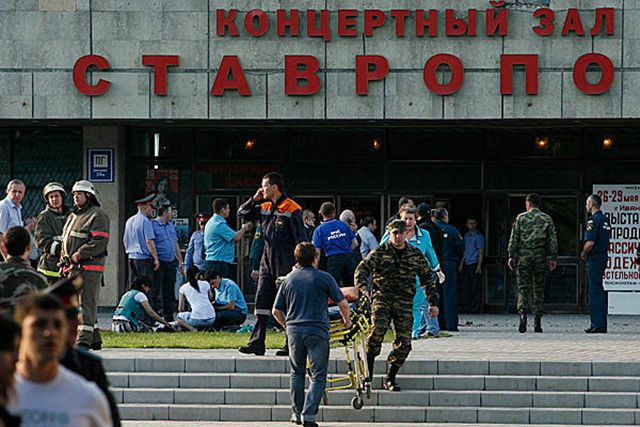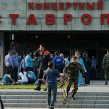
Attack in North Caucasus’ Safest City Casts Doubts on Moscow’s Policies in the Region
Publication: Eurasia Daily Monitor Volume: 7 Issue: 105
By:

Seven people died and over 40 were injured following the explosion near a concert hall in Stavropol on May 26. As of May 31, 32 people remained in the local hospital for treatment, five of whom were in critical condition (www.kavkaz-uzel.ru, May 31). According to estimates, the explosive device had the force of 400 grams of TNT. A de-facto emergency situation was instituted in Stavropol following the attack, with all transport and passengers entering the city being subject to police searches, police patrolling the streets and video surveillance systems hurriedly deployed in the city’s busy streets (Kommersant, May 28).
There are several intriguing details about this particular attack in Stavropol. The governor of Stavropol Krai, Valery Gaevsky, quickly followed up with a supposition that Moscow’s envoy to the North Caucasus Federal District, of which Stavropol region is a part, Aleksandr Khloponin, was the target of the attack (www.rbc.ru, May 27). If it were proven, it would be the first attempted physical attack on Khloponin, who was appointed to lead the North Caucasus Federal District in January 2010.
Another unusual feature of the attack was that it took place near a concert hall where a Chechen dance ensemble, Vainakh, was about to put on a performance, and thus several ethnic Chechens died in the explosion. This immediately gave rise to the theory that Russian nationalists were behind the blast. “I suppose that a kind of ultra-right [Russian] nationalist group could be behind these events,” said Anton Chablin, a journalist from Stavropol. Chablin said he had witnessed a noticeable rise in the number of nationalists in the city, along with the spread of fascist graffiti and slogans, over the last year. According to Chablin, an organization called Resistance was one of the most aggressive groups (www.rusnovosti.ru, May 27).
Stavropol Krai was included in the newly-created North Caucasus Federal District in January 2010. All the other parts of the district apart from Stavropol Krai are North Caucasian republics with non-Russian ethnic majorities, so voices of discontent could be heard in Stavropol after its people discovered they were incorporated into the predominantly non-Russian administrative entity. This may have caused further frustration among the Russian nationalists. Stavropol Krai has a population of 2.7 million and ethnic Russians comprise 82 percent of the total. Dagestan also has a population of 2.7 million, but its ethnic Russian component comprises a little less than 5 percent of the total (www.perepis2002.ru).
On May 30, Russian news agencies reported that six people were arrested in Ingushetia in connection with the Stavropol attack. According to the reports, the organizers and those who carried out the attack were detained (RIA Novosti, May 30). However, these reports were scrapped a short time later, with both the Federal Security Service (FSB) and interior ministry in Ingushetia energetically denying that there had been such arrests (www.ingushetiyaru.org, May 30). If an Ingush link to what appears to be an attack on Chechens in Stavropol were credibly established, it would aggravate relations between the Ingush and the Chechens, who are ethnic cousins.
Some observers pointed out that a blast in Nalchik, Kabardino-Balkaria, on May 1 (EDM, May 6) was very similar to the explosion in Stavropol. Therefore, some assumed that the same people organized both attacks. However, in its account of attacks during April and May, the insurgency in Kabardino-Balkaria claimed responsibility for the attack on the Nalchik hippodrome on May 1 but made no mention of any attack in Stavropol on May 26 (www.islamdin.com, May 31).
Meanwhile, on May 28, a special complex preventive regime was introduced in Kabardino-Balkaria to enable the police to operate freely in the republic. The special regime is one step short of a counter-terrorism operation regime and indicates how precarious the situation in the republic has become (www.kavkaz-uzel.ru, May 28). Yet, while the security situation in the republic does appear to be deteriorating, Russia’s security services may have a vested interest in introducing the even harsher counter-terrorism regime in Kabardino-Balkaria –in order to suppress the reviving nationalism of the Circassian people and ensure the safety of the Winter Olympics in Sochi in 2014, which many Circassian activists oppose because the games are being held on the land of the genocide of their ancestors in the nineteenth century.
Whether the attack in Stavropol was organized by Russian nationalists or the North Caucasian insurgency, it has dealt a serious blow to Aleksandr Khloponin’s ideology of normalization and economic development for the North Caucasus Federal District. The city of Stavropol was considered to be the safest city in the federal district, as it is the city in the district that is the farthest away from Chechnya, Ingushetia and Dagestan. Thus, if the safest city in the district could so easily be attacked, then other towns in the area are completely insecure and therefore unfit to receive significant private investment. If the attack was staged by Russian nationalists or, as is more likely, by their sympathizers in the Russian security services, then it also puts a limit on the ability of Moscow to freely adjoin or divide Russian and non-Russian administrative entities in the North Caucasus.




